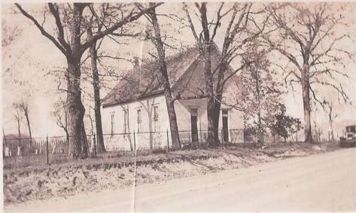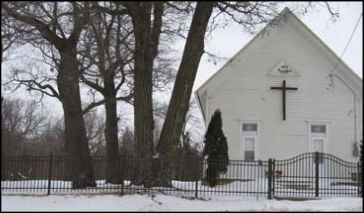 This mid-thirties snapshot of Pleasant Grove Church, built in 1874, shows the Church waiting patiently for the next event in its long history. That looks like a Model “A” Ford in the picture. The new fence, visible in the lower photo, was constructed in 2004. Added to the National Registry in 2010.
This mid-thirties snapshot of Pleasant Grove Church, built in 1874, shows the Church waiting patiently for the next event in its long history. That looks like a Model “A” Ford in the picture. The new fence, visible in the lower photo, was constructed in 2004. Added to the National Registry in 2010.
 This slightly different view of Pleasant Grove Church was taken on a cold winter's day in 2007. There is a legend that three of these trees at the southwest corner were planted as a memorial to a little girl who was killed in a stagecoach incident nearby. Also, in the legend category, is another that there is a small child buried to the immediate east of the south end of the Church and a tree was planted there as a Memorial to this youngster. This child was the youngster of some people who were migrating through the area on the stagecoach road and just happened to die when the family was in the vicinity, or so the legend says. Perhaps, there may be some truth in the stories but, on the other hand, maybe they are the same story modified over the years by repeated telling
This slightly different view of Pleasant Grove Church was taken on a cold winter's day in 2007. There is a legend that three of these trees at the southwest corner were planted as a memorial to a little girl who was killed in a stagecoach incident nearby. Also, in the legend category, is another that there is a small child buried to the immediate east of the south end of the Church and a tree was planted there as a Memorial to this youngster. This child was the youngster of some people who were migrating through the area on the stagecoach road and just happened to die when the family was in the vicinity, or so the legend says. Perhaps, there may be some truth in the stories but, on the other hand, maybe they are the same story modified over the years by repeated telling
the river did not retain as “even flow” as it had experienced before this time. The excess water arrived at the river quicker and did not remain on the prairie as it had formerly. This caused less water to be left in the slews, marshes, and ponds to percolate through the soil to maintain a more uniform river flow.
Notice in the ad that of the five crops mentioned, three are no longer grown in our area and the fourth, oats, is getting to be quite rare. **Iowa's “Great Lakes” reached record lows that summer that have never been matched.
In the Fall of 1855 Thomas Rinehart, (T.R.) Hughes bought the land where he constructed the Mill from John Morgan who had a 6 Dec 1853 patent on it. Hughes built the mill, probably starting in the spring of 1856, and used it as a saw mill and reportedly it was used in that capacity for 15 years. Hughes sold it to TK Soper in June of 1866. Soper sold it to Alznia Soper in Jan of 1883. In March of 1886 she sold it to James and Charles Keeney. Charles Keeney sold his interest to James Keeney in Sept of 1887 and James Keeney sold the mill to MW Templeton in April of 1889, and Templeton sold to Swearingen in Aug of 1896 with possession in March 1897. It was Swearingen who moved the Mill building back from the River in about 1907.
The millers information is much more tentative: Mill was run by Mr Yelton, apparently working for Soper, for nine years and he was the first miller. One report says Soper ran the mill as a saw mill for about 5 years and a different report says he immediately, in 1866, put in the burrs for grinding grain. The Mill produced a flour called “Soper's Superlative”. Hipsher and Eagleberger operated the mill from about 1871-1882. In spring of 1882, Jim Noble took over until about 1896. Circa 1894 or 1895: Dam was reconstructed 1895 River flow stayed too low for operation. 1896 P.J. Swearingen took over ownership from Templeton and Swearingen was, reportedly, a first class miller. Circa 1905: The mill dam gave way. Circa 1907: Barn moved back from the riverfront by Swearingen reportedly using “every” mule, horse and ox in the neighborhood.
When originally built, Soper's Mill was used a saw mill and during the construction of the railroad, cut up lumber (lots of walnut and oak) to be used as railroad ties for the railroad. These railroad ties were hauled to Iowa City and points in between by wagon to be used in the construction of the railroad which ended at Iowa City at the time. In May of 1862 daily Railroad service was available between the terminus, Otter Creek (Chelsea, Iowa), and Chicago with the trip taking 20 hours- leave Otter Creek at 10 AM and get to Chicago at 6 AM the next morning; return- 9:45 PM and into Otter Creek at 4:45 PM the next afternoon on the “Cedar Rapids and Missouri River” and the “Chicago, Iowa & Nebraska” Railroads. (Later to become the Chicago Northwestern) The Rail Road got to Nevada in 1864. T.R. Hughes had three nephews with him when he came to Iowa in 1856 and when the boys left to participate in the War and then did not return, T.R., age 53, lost much of his enthusiasm for ownership of the mill and sold it to Soper in 1866. (All three nephews survived the conflict.)